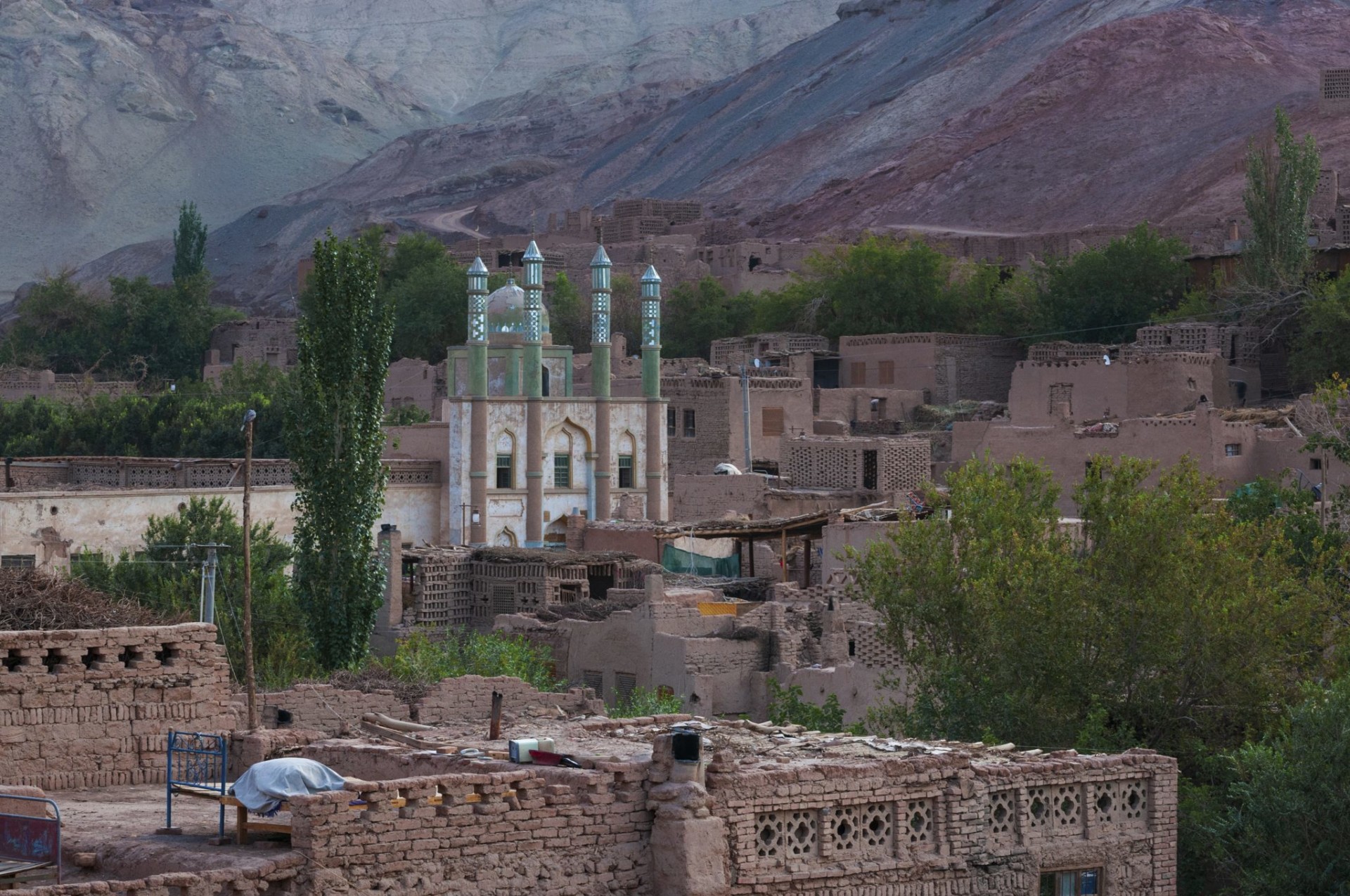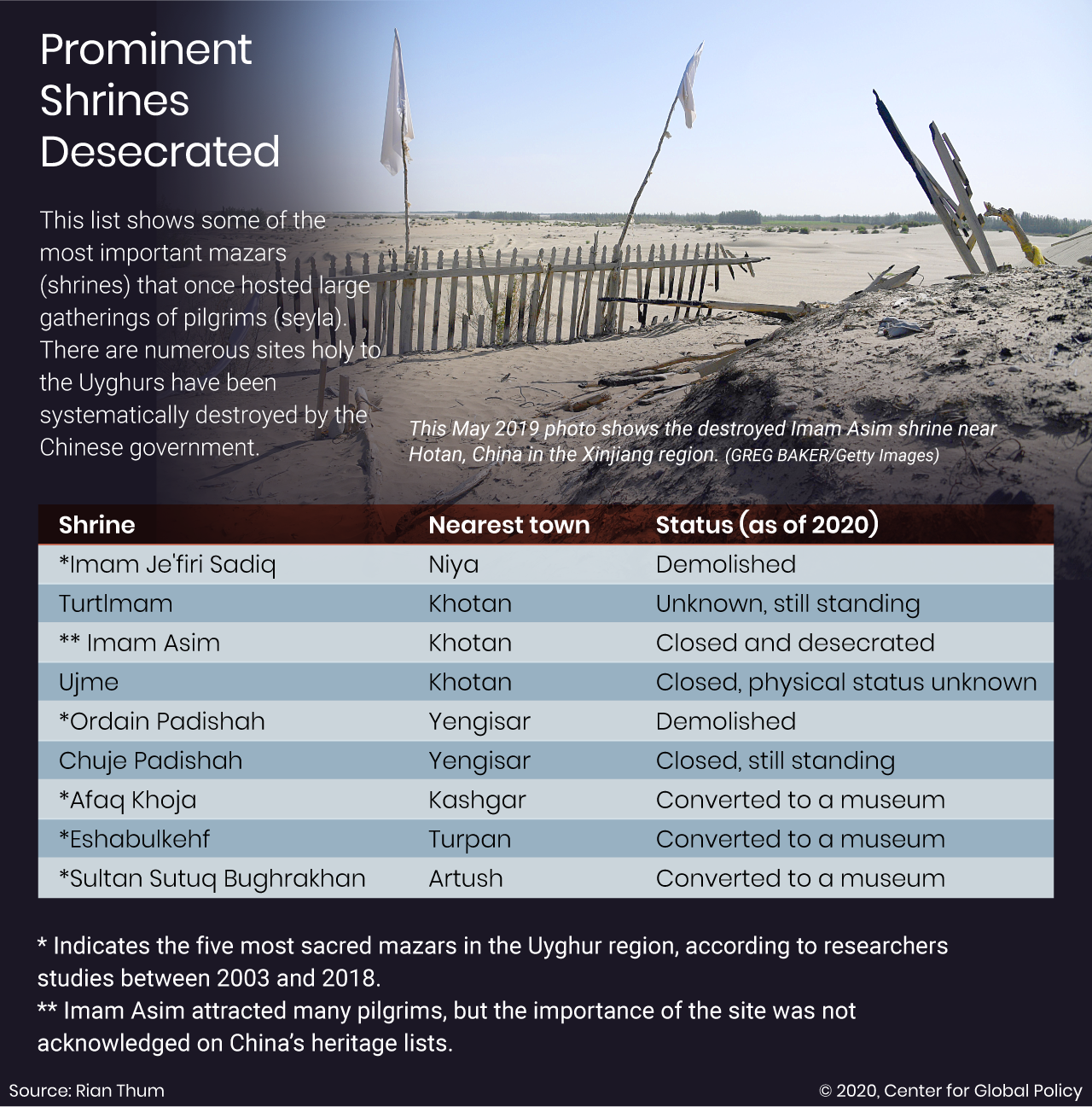
Over the past few years, China’s northwestern Xinjiang Uyghur Autonomous Region has been transformed into a police state, with an estimated 1.5 million of its Turkic Muslim citizens incarcerated and subjected to abusive regimes of indoctrination and forced labor. Uyghur cultural heritage is also under attack. Thousands of items of built heritage – mosques and sacred shrines – have been demolished in the course of China’s efforts to secure the region, and the communities surrounding them have been uprooted. Uyghur expressive culture – music, dance, and community gatherings – has been transformed into a propaganda tool.
Although China has justified its policies as necessary to counter extremism and terrorism, there is ample evidence to suggest that its actions amount to what UNESCO calls strategic cultural cleansing: the deliberate targeting of individuals and groups on the basis of their cultural, ethnic, or religious affiliation, combined with the intentional and systematic destruction of cultural heritage. Growing numbers of voices in the United States and elsewhere are describing China’s actions in Xinjiang a high-tech form of systematic genocide.
This attempt to remodel the region’s cultural landscape is impelled by the strategic and economic objectives of the Belt and Road Initiative (BRI), Chinese President Xi Jinping’s keystone policy introduced in 2013, which aims to secure access to the region’s natural resources and transform Xinjiang into a platform to expand China’s influence and trade across Central Asia.
Over the past two decades, China has become a key player in the international heritage sphere, an enthusiastic partner of UNESCO’s heritage initiatives, and a world leader in the number of items it has submitted to UNESCO’s prestigious heritage lists. China has developed its own unique approach to heritage management. Cultural heritage is linked to political goals; it serves as a resource for political legitimacy and soft power and an asset used to boost local economic development. China’s approach to heritage in Xinjiang is fully informed by its political strategy to pacify the region in pursuit of the economic and strategic goals of the BRI. China’s leading role in inscribing the Silk Road on UNESCO’s list of World Heritage Sites in 2014 demonstrates how it positions itself as an international heritage leader and how closely its heritage strategy is aligned with its economic and political goals.
Uyghur culture, in the form of the muqam musical repertoire and meshrep community gatherings, is strongly represented on UNESCO’s lists of Intangible Cultural Heritage. The Chinese government uses this seal of approval from UNESCO to argue that it is a responsible custodian of Uyghur culture and that government management of Uyghur culture is necessary to protect it from religious extremism. In fact, the biggest threats to Uyghur heritage are the policies of the Chinese government itself.
In practice, the management of Uyghur cultural heritage has been tightly tied to government attempts to deepen control over the Xinjiang region. In tandem with its program of destruction, the Xinjiang government has used Uyghur heritage as a cultural resource to develop the tourism industry. Key religious sites are preserved as tourist attractions while the local people are excluded and unable to worship. Grassroots cultural activities are criminalized as forms of “religious extremism,” but the same culture is put on display for tourist groups in song-and-dance spectacles. Tourism initiatives are typically led by Chinese companies, and benefits to Uyghurs have been uneven. The growth of tourism facilitates the movement of Han Chinese into the region, both as short-term visitors and permanent settlers, and provides additional justification for the repressive securitization policies, which are deemed necessary to stabilize the region.
Mosques, Shrines, and the Transmission of Uyghur History
Numerous items of Uyghur religious heritage — mosques and shrines — are included on China’s own national and regional heritage lists. Although recognized heritage sites should be protected under national laws, thousands of mosques and shrines, including protected sites, have been fully or partly demolished since 2016. The destruction of these sites is not only about cleansing the landscape of religious architecture but also part of a deliberate policy of erasing Uyghur cultural memory.
Up until the 1950s, when Xinjiang was incorporated into the People’s Republic of China, religious institutions were central to social and economic life. In the early 1950s, the city of Kashgar alone had 12,918 mosques. The major festival mosques were the site of mass celebrations at the festivals of Eid and Qurban. Madrassas (religious schools) provided the main source of formal education for Uyghur boys. The most distinctive and significant aspect of religious life centered around the shrines — tombs of martyrs and saints — which were popular pilgrimage destinations and held their own festivals celebrating the saint.
he spread of Islam into this region started in the 10th century with the conversion of the rulers of the Turkic Qarakhanid dynasty and their conquest of neighboring Buddhist kingdoms. Sufi orders played an important role in the introduction of Islam. Sufi sheikhs were respected as community leaders and venerated for their spiritual powers in life as well as in death; the shrines of these historical leaders and saints became important sites of pilgrimage.
These saints and their shrines have played a crucial role in the culture and history of the region. Most of these shrines are not major architectural monuments. Some of the most important shrines are simple mud brick constructions, distinguished visually by the huge temporary structures made up of “spirit flags” brought by pilgrims and attached to the shrines or tied together in tall flag mountains.
Religious Revival and ‘Strike Hard’ Campaigns
In the wake of the Cultural Revolution and with the relaxing of controls on religious life, Uyghurs began to return to their faith, and new forms of piety began to permeate Uyghur society. These trends mirrored revival movements across post-Soviet Central Asia and Hui Muslim Chinese communities. During my visits to the region in the early 2000s, I saw many people returning to family traditions of prayer, fasting, and modest dress; sending their children to Qur’an school; and saving money to go on the hajj. An important aspect of the revival was the building or reconstruction of community mosques. Local communities and individual donors raised money to build impressive structures that reflected a renewed pride in the faith and new community confidence and prosperity.
Already by the 1990s, the Xinjiang authorities were viewing these developments with deep suspicion. A series of “strike hard” campaigns began to target religious life. Everyday practices, such as daily prayer and fasting, veiling, or growing beards, were criticized as antisocial. Activities central to Uyghur culture, including shrine pilgrimage and religious instruction of children, were designated “illegal religious activities.”
Soon after America’s announcement of a “Global War on Terror,” China began to adopt the rhetoric of religious extremism and terrorism to justify its security policies in the region. Activities previously designated “illegal religious activities” were now dubbed “religious extremism.” State media began to designate local incidences of violence as “terrorist incidents” although the specific reasons underlying local violence were more often to do with local power struggles, official corruption and police brutality.
In May 2014, the recently appointed President Xi called for the construction of “walls made of copper and steel” to defend Xinjiang against terrorism. Uyghurs’ passports were confiscated, ties with the outside world were cut off, a tight net of surveillance tracked their every movement, and construction began on the system of mass internment camps.
The ‘Mosque Rectification’ Campaign
Rather than targeting the small number of people who might reasonably be judged as vulnerable to radicalization and violent action, the anti-religious extremism campaign in Xinjiang targeted all expressions of Islamic faith, and it removed swaths of Islamic architecture from Uyghur towns. Beginning in 2016 the Xinjiang authorities demolished thousands of mosques under a “mosque rectification” campaign. Many were condemned on the grounds that they were unsafe structures that posed a safety threat for worshippers. Others had their distinctive architectural features, such as domes and minarets, removed as part of the campaign to “Sinicize” Islam.
Investigations published in 2019 have provided case-by-case evidence of the demolition or modification of over 100 Uyghur mosques and several shrines, using satellite imagery to verify each site. The campaign did not just target physical infrastructure: Rahile Dawut, a Uyghur academic who had dedicated her life to documenting the shrines, was detained shortly before the demolitions in November 2017, one among hundreds of disappeared intellectuals and cultural leaders. She remains in an internment camp at the time of this writing.
Many Uyghur cemeteries were also destroyed or relocated during this period. CNN has revealed that more than a hundred cemeteries have been destroyed since 2018. The extremely rapid program of removing human remains for reburial elsewhere (assuming relatives claim them) and bulldozing structures left local people (even if they were not incarcerated in the camps) scant time to reclaim the bones of their family members.
Important historical shrines have been destroyed along with the cemeteries. Khotan’s Sultanim Cemetery, for example, has a history of over 1,000 years. It contained the shrine of the Four Sultans, an important pilgrimage site, and many other significant figures in Khotan’s history were buried in this cemetery. In March 2020, disinterment notices appeared around the city of Khotan, warning that the cemetery would be demolished within three days. According to satellite images, the site was completely flattened by April 2019, and part of the cemetery appeared to be in use as a parking lot.
Although the authorities have tried to justify the destruction or relocation of cemeteries by the demands of urban development, these moves form part of the wider effort to disrupt communities and break the transmission of Uyghur culture. As explicitly stated by Xinjiang official Maisumujiang Maimuer on state media in 2018, the aim is to “break their lineage, break their roots, break their connections, and break their origins.” Such projects of development and securitization attempt to remodel the cultural landscape and to re-engineer the desires and actions of its inhabitants.

Staging Uyghur Heritage
Against this backdrop of destruction and erasure, China still maintains its position as UNESCO’s principal partner in its heritage programs. Heritage is used in several ways to mask the damage that is being inflicted on Uyghur culture. China’s approach to heritage preservation has often been criticized for selecting isolated monuments for their symbolic value and not so much preserving them as “staging” them for the tourist industry. The transformation of the city of Kashgar remains the most notorious of these projects of architectural staging.
A gradual process of destruction and reconstruction of Kashgar’s old city began in the 1990s and was completed in 2013. The key heritage site of Idgah Mosque was preserved, but other historical sites were destroyed along with large swaths of residential areas. The majority of its inhabitants were rehoused elsewhere, and just as an estimated 10% of the adult population was incarcerated in the camp system and their children committed to “orphanages.” The old city was reopened in the form of a largely depopulated tourist destination. Former mosques were repurposed as tourist bars, and tourists were welcomed by staged performances of another kind of Uyghur heritage: the Uyghur meshrep.
Ratified by UNESCO in 2010, meshrep are forms of community gathering practiced by Uyghurs, which include food, music and dance, joking, and an informal “court” to discuss community issues. They fit well with the 2003 Convention on Intangible Cultural Heritage, which aims to safeguard practices which are “essential for communities’ cultural identity,” emphasizing the importance of grassroots practice, and the key role of practitioners and communities in safeguarding initiatives.
In practice, the process of safeguarding meshrep in Xinjiang has seen its transformation from community gathering into staged song-and-dance spectacle. Since 2012, grassroots meshrep have fallen afoul of the criminalization of informal gatherings, and ordinary Uyghurs have been unable to organize their own meshrep. Instead, meshrep have become a cultural resource used to promote the tourism industry and deployed in soft diplomacy initiatives. Lavish shows like “China Dream on the Silk Road” and “Forever Meshrep” promote Xi’s policies on the international stage. Within the region, staged performances of Uyghur heritage present a vision of dancing young women, smiling and welcoming tourists under the surveillance cameras while a million of their fellows are incarcerated.
We have also seen meshrep deployed at the heart of the anti-religious extremism campaign. In 2014, local governments organized a “weekly meshrep to tackle extremism” campaign, which involved compulsory singing and dancing sessions for Uyghur villagers to “cure” them of the virus of Islam. China’s “safeguarding” of meshrep thus involves separating the practice from its community roots, and creating versions that promote repressive government campaigns. UNESCO ratification allows the Chinese government to present itself on the international stage as protecting Uyghur heritage, masking the reality that security policies severely hamper the practice and transmission of that heritage.
In spite of its own laws addressing the protection of cultural heritage, China has implemented unprecedented processes of cultural erasure in Xinjiang, with little redress or consequence. China has strongly refuted all criticism, conducted a campaign of harassment of Uyghur exiles who speak out, and orchestrated statements of support from its allies, including many majority Muslim countries that happen to be recipients of BRI development loans. U.S. government responses to the crisis, especially the Uyghur Human Rights Bill, are welcome in terms of the pressure they are bringing to bear on companies who profit from Uyghur forced labor. It is now time to prioritize the cultural sphere in the international response to the Xinjiang crisis, to ensure that China cannot continue to use international heritage conventions to whitewash its policies of cultural erasure.
Observers have long noted UNESCO’s apparent incapacity to counter or even protest abuses of the heritage system by state partners. International cultural organizations and national governments need to call on UNESCO to implement new review systems and mechanisms so that state parties to its conventions cannot pursue policies which amount to cultural genocide while enjoying UNESCO’s seal of approval for its “protection” of the same cultural heritage. China’s prominence in the international heritage regime means that it is all the more crucial that UNESCO should be seen to act.
Recommendations
In bilateral and multilateral exchanges, U.S. government bodies should raise private and public concerns about the deliberate destruction of built cultural heritage in Xinjiang.
U.S. cultural agencies should boycott Chinese cultural exchange programs relating to Xinjiang and the Silk Road.
U.S. government and civil society institutions should prioritize support for cultural preservation projects and documentation and translation of Uyghur cultural heritage.
The U.S. government should call on UNESCO to conduct an independent investigation of China’s approach to safeguarding Uyghur intangible heritage, and to withdraw its ratification of these items if China’s measures do not accord with the standards of the 2003 Convention.
The U.S. government should bring pressure to bear on UNESCO to:
– link its ratification of state projects to “safeguard cultural heritage” more tightly to human rights concerns
– develop and implement a review mechanism with a focus on the human rights aspects of safeguarding heritage
– introduce consequences for state parties to UNESCO conventions on heritage who fail to abide by international human rights instruments, particularly when those rights violations touch on the heritage items included on UNESCO’s lists
Dr. Rachel Harris is Professor of Ethnomusicology at SOAS, University of London. Dr. Harris’ research focuses on expressive and religious culture, heritage and state policy in China’s Muslim borderlands. Harris led the Leverhulme Research Project “Sounding Islam in China” (2014-2017) and now heads a British Academy Sustainable Development Project to revitalize Uyghur cultural heritage in the diaspora. Her new book Soundscapes of Uyghur Islam will be out in November 2020, and an edited volume Ethnographies of Islam in China will be published in Spring 2021.
